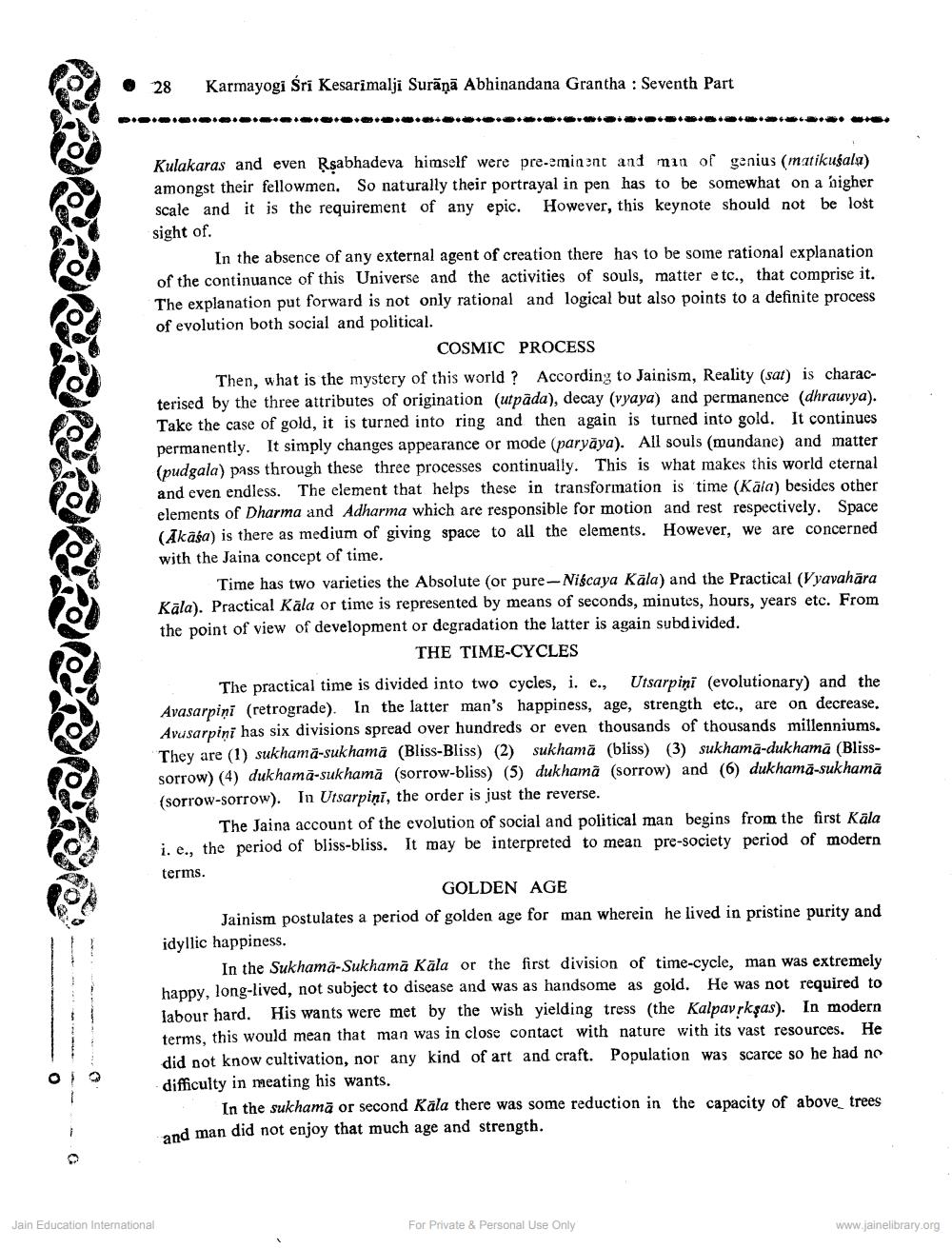________________
-0
0
28
Karmayogi Śri Kesarimalji Surāņā Abhinandana Grantha : Seventh Part
Kulakaras and even Ṛsabhadeva himself were pre-eminent and man of genius (matikusala) amongst their fellowmen. So naturally their portrayal in pen has to be somewhat on a higher scale and it is the requirement of any epic. However, this keynote should not be lost
sight of.
In the absence of any external agent of creation there has to be some rational explanation of the continuance of this Universe and the activities of souls, matter etc., that comprise it. The explanation put forward is not only rational and logical but also points to a definite process of evolution both social and political.
COSMIC PROCESS
Then, what is the mystery of this world? According to Jainism, Reality (sat) is characterised by the three attributes of origination (utpada), decay (vyaya) and permanence (dhrauvya). Take the case of gold, it is turned into ring and then again is turned into gold. It continues permanently. It simply changes appearance or mode (paryaya). All souls (mundane) and matter (pudgala) pass through these three processes continually. This is what makes this world eternal and even endless. The element that helps these in transformation is time (Kala) besides other elements of Dharma and Adharma which are responsible for motion and rest respectively. Space (Akasa) is there as medium of giving space to all the elements. However, we are concerned with the Jaina concept of time.
Jain Education International
Time has two varieties the Absolute (or pure-Niscaya Kala) and the Practical (Vyavahāra Kala). Practical Kala or time is represented by means of seconds, minutes, hours, years etc. From the point of view of development or degradation the latter is again subdivided.
THE TIME-CYCLES
The practical time is divided into two cycles, i. e., Utsarpini (evolutionary) and the Avasarpini (retrograde). In the latter man's happiness, age, strength etc., are on decrease. Avusarpini has six divisions spread over hundreds or even thousands of thousands millenniums. They are (1) sukhamā-sukhamā (Bliss-Bliss) (2) sukhamā (bliss) (3) sukhamā-dukhamā (Blisssorrow) (4) dukhama-sukhamā (sorrow-bliss) (5) dukhama (sorrow) and (6) dukhama-sukhamā (sorrow-sorrow). In Utsarpiņi, the order is just the reverse.
The Jaina account of the evolution of social and political man begins from the first Kala i. e., the period of bliss-bliss. It may be interpreted to mean pre-society period of modern
terms.
GOLDEN AGE
Jainism postulates a period of golden age for man wherein he lived in pristine purity and idyllic happiness.
In the Sukhama-Sukhamā Kāla or the first division of time-cycle, man was extremely happy, long-lived, not subject to disease and was as handsome as gold. He was not required to labour hard. His wants were met by the wish yielding tress (the Kalpavṛksas). In modern terms, this would mean that man was in close contact with nature with its vast resources. He did not know cultivation, nor any kind of art and craft. Population was scarce so he had no difficulty in meating his wants.
In the sukhamă or second Kala there was some reduction in the capacity of above trees and man did not enjoy that much age and strength.
For Private & Personal Use Only
www.jainelibrary.org




